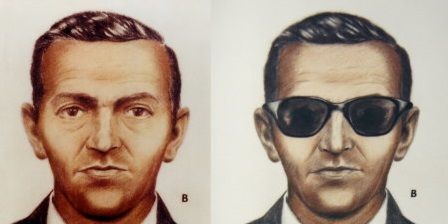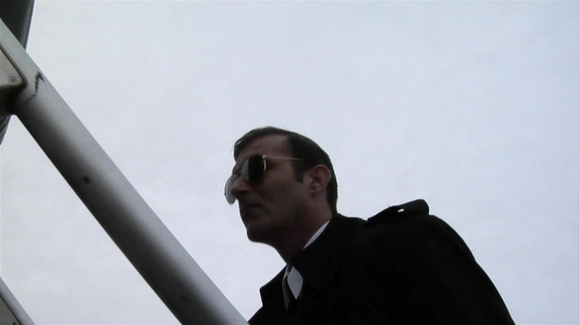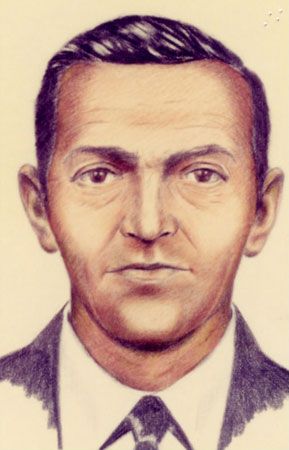National georgaphic had a special on D.B. Cooper
In 1971, a hijacker, named Dan Cooper, parachuted from a plane with a request of $200,000, crafting the FBI's only unsolved hijacking case. With help of modern forensics, experts hope DNA analysis will solve the mystery.

www.nationalgeographic.com
One conclusion they had on the reason Cooper never turned up is because he is probably dead...
that he landed in the C
olumbia River and died; but that he would never be found is because at that time the river was a avenue for ocean going ships; that his remains were caught by a sea going ship and are now at the bottom of the sea --except for a portion which broke away and was found in 1980.
Likewise there are several clues to his identity:
1) First, Cooper appeared to lack the necessary
skydiving knowledge, skills, and experience for the type of jump he attempted. "We originally thought Cooper was an experienced jumper, perhaps even a paratrooper," said Carr. "We concluded after a few years this was simply not true. No experienced parachutist would have jumped in the pitch-black night, in the rain, with a 172 mph [77 m/s] wind in his face wearing loafers and a trench coat. It was simply too risky."Skydiving instructor Earl Cossey, who supplied the parachutes, testified Cooper did not need extensive experience to survive the jump and "anyone who had six or seven practice jumps could accomplish this." However, Cossey also noted jumping at night drastically increased the risk of injury, and without jump boots, Cooper probably would have suffered severe ankle or leg injuries upon landing.
Second, Cooper did not appear to have the equipment necessary for either his jump or his survival in the wilderness. Cooper failed to bring or request a helmet, and jumped into a 15 °F (−9 °C) wind at 10,000 feet (3,000 m) in November over Washington State without proper protection against the extreme
wind chill
Larry Carr, who led the investigative team from 2006 to 2009, does not believe Cooper was a paratrooper. Instead, Carr speculates Cooper had been an Air Force aircraft cargo loader. An aircraft cargo-loading assignment would provide him with aviation knowledge and experience: cargo loaders have basic jump training, wear emergency parachutes, and know how to dispatch items from planes in flight. As a cargo loader, Cooper would be familiar with parachutes, "but not necessarily sufficient knowledge to survive the jump he made
2)Cooper appeared to be familiar with the Seattle area and may have been an Air Force veteran, based on testimony that he recognized the city of Tacoma from the air as the jet circled Puget Sound, and his accurate comment to Mucklow that McChord Air Force Base was about 20-minutes' driving time from Seattle-Tacoma Airport—a detail most civilians would not know or comment upon
3)Agents theorized that Cooper took his alias from a popular French-language Belgian comics series featuring the fictional hero Dan Cooper, a Royal Canadian Air Force test pilot who took part in numerous heroic adventures, including parachuting. (One cover from the series, reproduced on the FBI website, depicts test pilot Cooper skydiving.)Because the Dan Cooper comics were never translated into English, nor imported to the U.S., they speculated that he had encountered them during a tour of duty in Europe
Clues to his profession?
In March 2009, a group of "citizen sleuths" using GPS, satellite imagery, and other technologies unavailable in 1971,began reinvestigating components of the case. Known as the Cooper Research Team (CRT),the group included
paleontologist Tom Kaye from the
Burke Museum of Natural History and Culture in Seattle, scientific illustrator Carol Abraczinskas, and
metallurgist Alan Stone. Although the CRT obtained little new information about the buried ransom money or Cooper's landing zone, they found, analyzed, and identified hundreds of organic and metallic particles on Cooper's tie.
Using
electron microscopy, the CRT identified
Lycopodium spores, the source of which was likely pharmaceutical. The team also found minute particles of unalloyed
titanium on the tie, along with particles of
bismuth,
antimony,
cerium,
strontium sulfide,
aluminum, and titanium-antimony alloys. The metal and
rare-earth particles suggested Cooper may have worked for Boeing or another aeronautical engineering firm, at a chemical manufacturing plant, or at a metal fabrication and production facility.
The material with the most significance, explained Kaye, was the unalloyed
titanium. In the 1970s, the use of pure titanium was rare and would only be used in aircraft fabrication facilities, or at chemical companies combining titanium and aluminum to store extremely corrosive substances. The cerium and strontium sulfide were used by
Boeing's
supersonic transport development project, and by Portland factories in which
cathode ray tubes were manufactured, such as
Teledyne and
Tektronix. Cooper researcher Eric Ulis has speculated the titanium-antimony alloys are linked to Rem-Cru Titanium Inc., a metals manufacturer and Boeing contractor.
[
3) He wanted the money in negotiable American currency.
Implication that Cooper was a non american such as being from Canada
A man who parachuted out of an airplane in 1971 with a bag full of stolen cash has never been seen again in one of the great unsolved mysteries in FBI history.

www.fbi.gov
ref:
D. B. Cooper - Wikipedia.




